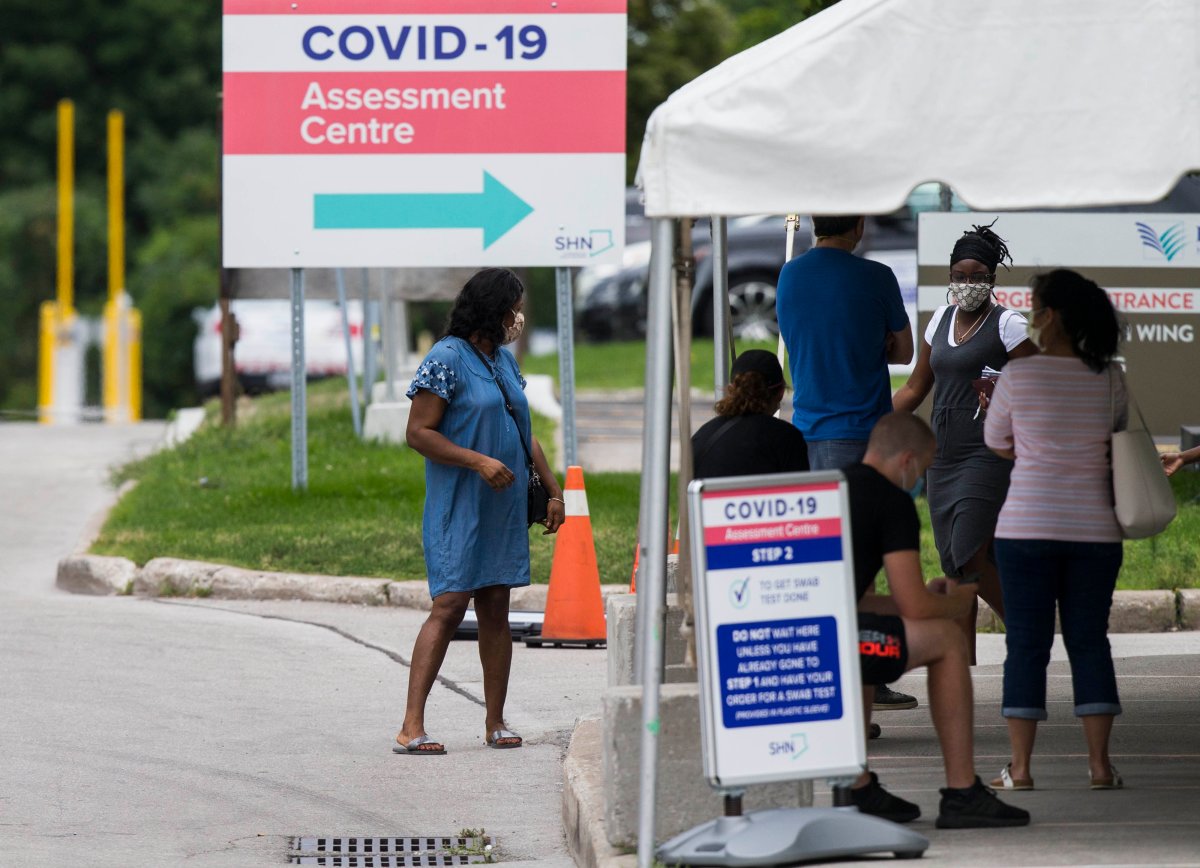Five people have tested positive for the novel coronavirus and 16 people have recovered, officials with the Middlesex-London Health Unit (MLHU) reported Saturday.

That brings the region’s total case count to 888, of which 770 people have recovered. The death toll, 57, has remained unchanged since June 12.
There are at least 61 active cases in the region. As many as 156 cases have been reported since the start of September amid an ongoing second wave of the virus, according to the health unit.
The region’s incident rate is at 175.0 per 100,000 people, while Ontario’s was 356.4
On Friday the MLHU reported three new cases with 11 recoveries.
No new cases reported Friday were linked to elementary or secondary schools in the city. Only one has been confirmed so far — reported early last week at H.B. Beal Secondary involving a student.
As of Thursday, at least 70 cases have been tied to students at Western University since the start of September. The health unit says it will refrain from issuing a further tally as student cases have been fewer this week compared to previous weeks.
Two student-associated community outbreaks declared in mid-September are, “for all intents and purposes,” over, according to Dr. Chris Mackie, the region’s medical officer of health.
Health officials reported six cases and 11 recoveries Thursday, nine cases and 18 recoveries Wednesday, one case and one recovery Tuesday, and eight cases and one recovery Monday.

The city’s two COVID-19 assessment centres, like all assessment centres in the province, will both soon be accessible by appointment only.
The province announced Friday that assessment centres will transition to appointment-based testing starting on Oct. 6, and that walk-in testing services will be discontinued starting Sunday to help clear a massive 90,513-test backlog.
It was just on Thursday that the Thames Valley Family Health Team (TVFHT), which operates London’s two assessment centres alongside the London Health Sciences Centre, announced Oakridge Arena would move to appointment-only, while Carling Heights would take only walk-ins.
Those changes had been expected to come into place starting next week.
- Canadian man dies during Texas Ironman event. His widow wants answers as to why
- ‘Super lice’ are becoming more resistant to chemical shampoos. What to use instead
- Canadians more likely to eat food past best-before date. What are the risks?
- Treatment from female doctors leads to lower death rates, study finds
In an interview with 980 CFPL on Friday, Mike McMahon, executive director of TVFHT, said Oakridge would move ahead with its phone-based appointment system, while Carling Heights would continue operating with its current ticketing system until phone or online appointment bookings were set up.
Currently, people who attend Carling Heights are given a ticket with a time to come back later for a coronavirus swab.
Regarding a timeline for when Carling Heights would start taking phone or online appointments, McMahon said he wouldn’t want to promise a date.
“We’re committed to continuing to pass out the ticket that offers you a return appointment time, the same way we’ve been doing for the last seven to ten days, and we’re working hard to see if the volumes will permit us a further switch to the booked appointment by telephone in the very near future,” he said.
McMahon said the current ticketing system at Carling isn’t a true walk-in option, where health-care workers serve whoever has shown up on a certain day until the centre closes regardless of how many people there are.
“We had to move away from that in the middle of September because we were overwhelmed and we couldn’t do the volume of testing that folks were looking for,” he said.
Starting next week, locals looking to book an appointment by phone at Oakridge Arena can call 519-667-6886 and leave a message.
Elsewhere, appointment-only asymptomatic testing at three Shoppers Drug Mart locations in London launched earlier this week, as did the Middlesex-London Paramedic Service’s mobile testing bus.
The bus will be at the Strathroy Gemini Arena on Monday.
Those looking to get tested are best to show up early. The bus reached capacity around noon on Thursday, and just after 10:30 a.m. on Wednesday — the day it launched.
Testing in primary care clinics is also important in discussions around testing capacity, but Mackie says few are currently offering tests, despite them being available.
“The big challenge there is that a lot of primary care centres, a lot of the family doctors’ offices, are not set up to do the testing. They have some infection control practices in place, but a waiting room isn’t necessarily a great place for two-metre physical distancing,” he said.
Four institutional outbreaks remain active at seniors’ homes in London and Middlesex, according to the health unit.
At least 32 institutional outbreaks have been declared in the region during the pandemic, including 26 at seniors’ facilities.
The most recent outbreaks, both declared on Sept. 24, are located at Meadow Park Care Centre in its blue and yellow units and at Peoplecare Oak Crossing in its Red Oak area.
Two facility-wide outbreaks also remain at Country Terrace and Ashwood Manor Retirement Home.
Overall, the health unit says the institutional outbreaks have been linked to at least 201 of the region’s cases, with 108 residents and 92 staff infected. The outbreaks have also left 37 people dead.
Hospitalizations in the region remain low according to London Health Sciences Centre. The hospital system has not issued an updated tally since mid-June, saying it will only do so if cases involving patients rise above five.
Similarly, it has also not reported any staff cases in recent months.
St. Joseph’s Health Care London also said Saturday it had no COVID-19 patients in its care. The tally of staff cases there, 19, has also not changed in several months.
A total of 117 people have been hospitalized, including 32 who have needed intensive care. A vast majority of those hospitalized have been people over the age of 50.
By age, health unit figures show people in their 20s account for the highest number of cases, with 206, or about 23.3 per cent. At least 53 cases have been reported since the start of September.
People in their 50s make up 120 of the region’s cases, or about 13.6 per cent, while those in their 30s and those 80 and above make up 116 and 111 cases, respectively.
Those aged 19 and under make up 94 cases — at least 55 of which have come within the last 30 days.
Ontario
Provincially, Ontario reported 653 new cases of COVID-19 on Saturday, one day after a new daily record was set on Friday with 732.
Health Minister Christine Elliott there were 284 new cases in Toronto, 104 in Peel and 97 in Ottawa Oct. 3.
Elliott says 64 per cent of the new cases are among people under the age of 40.
The latest figures mean Ontario has seen a total of 53,633 COVID-19 cases with just over 84 per cent – a total of 45,285 cases resolved.
A total of 41 deaths were reported on Saturday, 37 of which are from the spring or summer and part of the data remediation. The provincial death toll now stands at 2,968.
The province said Friday it was introducing a slate of new restrictions in a bid to curb a surge in COVID-19 cases.
Ontario is making COVID-19 testing available by appointment only, making masks mandatory in public indoor spaces across the province, and tightening restrictions on businesses in virus hot spots.
Premier Doug Ford says that starting Saturday, restaurants, bars, gyms and banquet halls in those areas will face tighter restrictions to help curb the spread of COVID-19.
He says no more than 100 customers will be allowed in restaurants and no more than six people will be permitted at a table.
The government also said it is putting a “pause” on 10-person social bubbles.
It said that all Ontarians should only have close contact with those who live in the same household and people should maintain a two-metre physical distance from everyone else. Those who live alone can consider having close contact with another household, the government said.
Elgin and Oxford
Southwestern Public Health (SWPH) has reported one new recovery on Saturday.
The recovery, a female in there 20s, brings the total number of recoveries to 259.
The region’s total novel coronavirus case count remains unchanged at 270. Five people have died during the pandemic, most recently in early July.
There are six known active cases in the region, all in St. Thomas, health unit figures show.
Health officials reported one new case on Thursday and two new cases and two recoveries on Wednesday.
Only one case has been reported involving an elementary or secondary school in the region. The case, reported Tuesday, involves a student at Mitchell Hepburn Public School in St. Thomas.
Of the region’s active cases, two people are under the age of 10, one is in their 20s, two are in their 30s, and one is in their 60s. Four are female and two are male.
No people are currently in hospital within SWPH’s jurisdiction. A total of 23 have been reported during the pandemic, including 11 who have needed intensive care.
There was no update in the exposure source of five of the active cases, which are listed as ‘under investigation’. One case is due to close contact.
Overall, the health unit says 51 cases, or 19 per cent, have involved people in their 50s, while 50 cases, or 18.5 per cent, have been people in their 20s. People in their 40s make up 38 cases, or 14 per cent.
At least 108 cases of the region’s total count have been linked to close contact, health unit figures show. Workplaces are linked to 39 cases, while 27 involve health-care workers, 25 involve travel and 13 are tied to social gatherings.
The exposure source is unknown for at least 55 cases. Seven are under investigation.
During the pandemic, Aylmer has recorded the most cases, 82, followed by St. Thomas with 44, Bayham with 38, Woodstock with 30, Tillsonburg with 25 and Dutton/Dunwich with 10.
Ten other communities have case counts in the single digits.
The region’s per cent positivity rate was 0.1 per cent for the week of Sept. 20, the most recent data available. Nearly 3,000 tests were conducted that week.
Huron and Perth
Huron Perth Public Health Does not update numbers on the weekend. The region’s overall case count stood at 129 as of Friday.
At least 122 recoveries have been reported along with five deaths, leaving a total of two active cases in the region.
No change was reported Thursday or Wednesday in regard to the region’s case, death, or recovery tallies.
The health unit has reported 46 cases in Perth County and 45 in Huron County.
Elsewhere, Stratford has seen 32 cases, and St. Marys has seen six. Four deaths have been reported in Stratford and one in St. Marys.
At least 27 cases have been linked to people in their 20s, followed by people in their 50s with 24 and people in their 60s with 22. At least 55 per cent of cases involve women and girls.
Some 37,438 tests had been conducted by the health unit as of Sept. 20, the most recent figures available. That week saw 2,269 tests completed and a per cent positivity rate of 0.1 per cent.
Sarnia and Lambton
Officials with Lambton Public Health (LPH) reported no new cases or recoveries late Friday.
The region’s total count is at 347, of which 319 people have recovered. Twenty-five people have died, most recently in early June.
One new case of the novel coronavirus was reported on Thursday.
There are at least three active cases of the virus in the county. The locations of the cases are unclear as the health unit does not release such information.
Health officials reported one recovery late Wednesday and no change late Tuesday.
The county has reported at least eight cases since the start of September, a change from the 22 seen in August. Thirty-two cases were seen in July, due in large part to a 15-case spike reported at the end of the month.
As part of the province’s announcement on Friday, masks will now be mandated across Lambton County as well as the rest of the province.
Lambton has been one of the only regions in the province, if not the only region, that hasn’t had some form of widespread mask mandate in place.
Lambton Public Health had refrained from implementing one, saying in July that caseloads at the time and the county’s largely rural population didn’t warrant one.
Masks were therefore left up to each municipality to deal with. Several municipalities within the county, including Sarnia, later put mask bylaws in place.
Last month, the county’s council reaffirmed it’s previous decision to not issue a Lambton-wide order.
No change has been reported to the region’s overall hospitalization count, which has stayed at 58 since late May, or to its outbreak count, which has remained at 10 since mid-August.
By age, people 80 and up account for at least 76 cases, while people in their 50s make up 52 and people in their 20s account for 50.
At least 197 cases, or 57 per cent, involve women and girls. At least 18 per cent of all cases involve health-care workers.
According to health officials, a total of 27,811 tests have been received as of Sept. 27. Only six per cent of the 1,181 cases done the previous week had a turnaround time of within two days.
–With files from Matthew Trevithick, Ryan Rocca The Canadian Press












Comments